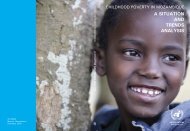Mozambican Civil Society Within: - UNICEF Mozambique - Home page
Mozambican Civil Society Within: - UNICEF Mozambique - Home page
Mozambican Civil Society Within: - UNICEF Mozambique - Home page
You also want an ePaper? Increase the reach of your titles
YUMPU automatically turns print PDFs into web optimized ePapers that Google loves.
<strong>Mozambican</strong> <strong>Civil</strong> <strong>Society</strong> <strong>Within</strong>: Evaluation, Challenges, Opportunities and Action<br />
Yussuf Adam and Humberto Coimbra (1997) Frelimo and the state saw themselves as the only<br />
legitimate representatives of the people and the few agencies that existed had to submit to their<br />
control. (Adam and Coimbra, 1997: 83; Newitt, 1997: 467).<br />
Even the so-called “democratic mass organisations” (DMOs) were subject to strict directive<br />
controls that excluded diversity. Social control of women was exercised by the <strong>Mozambican</strong><br />
Women’s Organisation (OMM); for youth there was OJM, for wage workers the OTM, for<br />
teachers the ONP, for journalists the ONJ, among others.<br />
However, as in colonial times, during the first decade of independence there were also actions<br />
to free society from the strict control of the state or the single party. In addition to the extreme<br />
example, involving the armed opposition launched by RENAMO, there were also peaceful<br />
examples associated, for example, with the Christian Council of <strong>Mozambique</strong> (CCM) and the<br />
appearance of Caritas <strong>Mozambique</strong> as well as the State’s constant difficulties in facing the<br />
peasant movement that created the National Union of Peasants (UNAC) (Negrão, 2003).<br />
Figure 2.1.1: Non-Profit Organisations and Period of Birth, Year 2003<br />
Number of CSO<br />
900<br />
800<br />
700<br />
600<br />
500<br />
400<br />
300<br />
200<br />
100<br />
0<br />
170<br />
691<br />
230<br />
350<br />
703<br />
257<br />
Religious<br />
associations 846<br />
Political Associations 567<br />
61<br />
13 15<br />
Foreign NGOs 99<br />
26<br />
4 7<br />
Educational associations 59<br />
Before 1974 From 1974 to 1983 From 1984 to 1993 From 1994 to 2003<br />
Períod of birth<br />
Religious associations<br />
Political Associations<br />
Educational associations<br />
Foreign NGOs<br />
Fonte: INE, 2006: 98<br />
Before 1984 there were a few associations in <strong>Mozambique</strong>. References to Non-Governmental<br />
Organizations include the <strong>Mozambique</strong> Red Cross, the General Cooperative Union, Doctors<br />
Without Borders and associations linked to the Frelimo party (OMM for example). After the<br />
introduction of freedom of association the number of NGOs started to rise.<br />
In 2003 the INE conducted a census of 4853 Non-Profit Institutions in <strong>Mozambique</strong>. Over 70%<br />
of these associations worked in just 5 provinces while less than 30% were active in the remaining<br />
six provinces. Most units were concentrated in Nampula province (19.5%), followed by Gaza<br />
(14.6%), Inhambane (14%), Maputo city (12.9%) and Maputo province (9.5%). In the remaining<br />
provinces the number was less than or equal to 6.1% (INE, 2006:43).<br />
18<br />
<strong>Civil</strong> <strong>Society</strong> Index, <strong>Mozambique</strong> 2007
















